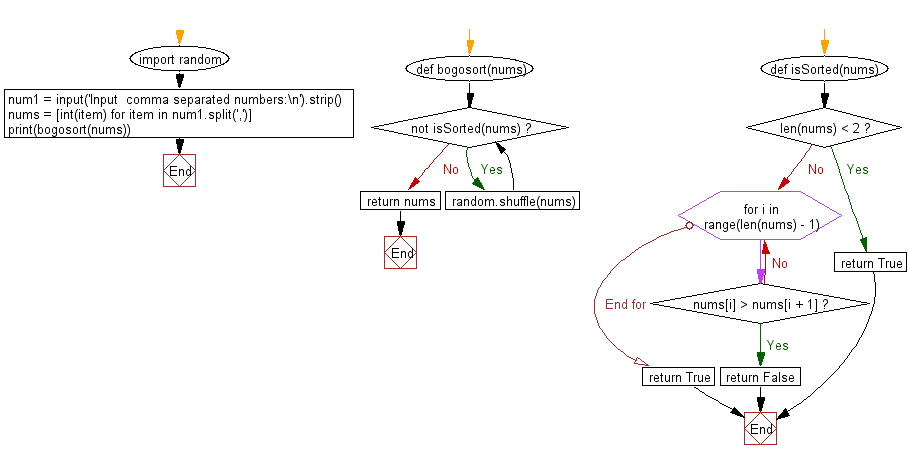Python: Sort a list of elements using Bogosort sort
12. Bogosort
Write a Python program to sort a list of elements using Bogosort sort.
In computer science, Bogosort is a particularly ineffective sorting algorithm based on the generation and test paradigm. The algorithm successively generates permutations of its input until it finds one that is sorted. It is not useful for sorting, but may be used for educational purposes, to contrast it with other more realistic algorithms.
Two versions of the algorithm exist: a deterministic version that enumerates all permutations until it hits a sorted one, and a randomized version that randomly permutes its input. An analogy for the working of the latter version is to sort a deck of cards by throwing the deck into the air, picking the cards up at random, and repeating the process until the deck is sorted. Its name comes from the word bogus.
Sample Solution:
Python Code:
import random
def bogosort(nums):
def isSorted(nums):
if len(nums) < 2:
return True
for i in range(len(nums) - 1):
if nums[i] > nums[i + 1]:
return False
return True
while not isSorted(nums):
random.shuffle(nums)
return nums
num1 = input('Input comma separated numbers:\n').strip()
nums = [int(item) for item in num1.split(',')]
print(bogosort(nums))
Sample Output:
Input comma separated numbers: 15, 25, 37, 65, 75, 12, 89 [12, 15, 25, 37, 65, 75, 89]
Flowchart:

For more Practice: Solve these Related Problems:
- Write a Python program to implement the randomized version of bogosort and count the number of shuffles required for sorting.
- Write a Python script to perform bogosort on a small list and measure the execution time for worst-case inputs.
- Write a Python program to demonstrate bogosort on a list of characters and print each permutation attempted.
- Write a Python function to implement a deterministic bogosort that generates all permutations until the sorted one is found.
Go to:
Previous: Write a Python code to create a program for Bitonic Sort.
Next: Write a Python program to sort a list of elements using Gnome sort.
Python Code Editor:
Contribute your code and comments through Disqus.
What is the difficulty level of this exercise?
Test your Programming skills with w3resource's quiz.
